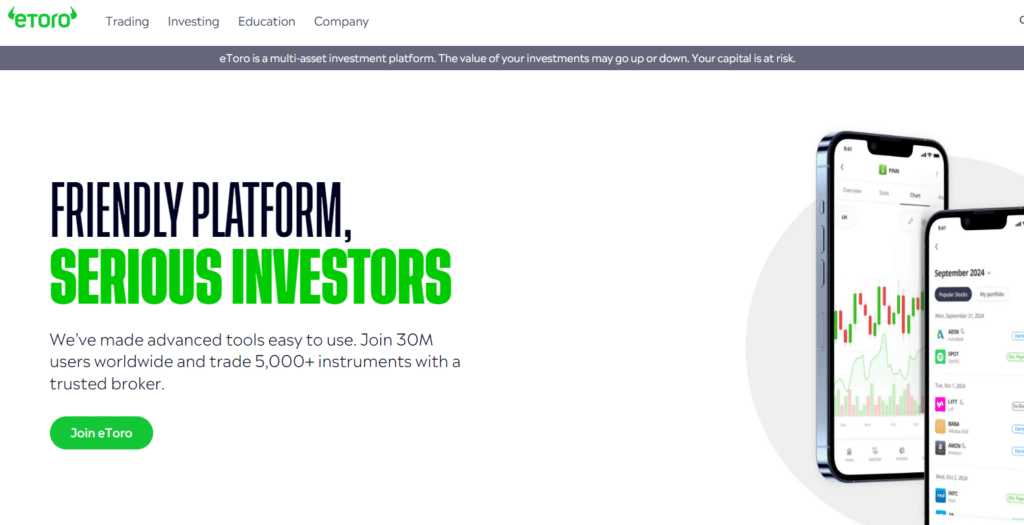How to Buy Apple Shares in the UK

Thomas Drury
Co-Founder
Seasoned finance professional with 10+ years' experience. Chartered status holder. Proficient in CFDs, ISAs, and crypto investing. Passionate about helping others achieve financial goals.
Twitter ProfileAuthor Bio

Dom Farnell
Co-Founder
Dom is a Co-Founder and of TIC. A passionate investor and seasoned blog writer with a keen interest in financial markets and wealth management.My goal is to empower individuals to make informed investment decisions through informative and engaging content.
Twitter ProfileAuthor Bio
How We Test
At The Investors Centre, we pride ourselves on our rigorous fact-checking process. To delve deeper into our meticulous testing procedures and discover how we ensure accuracy and reliability, visit our dedicated page on how we test.

Please bear in mind that the value of investments can decrease in addition to increasing, which means there is a possibility of receiving an amount lower than your initial investment. It is generally advisable to retain your investments for a minimum of five years in order to maximize the likelihood of achieving your desired returns. Capital at risk.
Quick Answer – How to Buy Apple Shares in the UK 2024?
Buying Apple shares in the UK in 2024 has become more accessible than ever, catering to both seasoned investors and beginners. The process typically involves a few key steps:
Select a Trading Platform or Broker: Choose a reputable online trading platform or broker that operates in the UK. Look for platforms offering competitive fees, user-friendly interfaces, and robust security measures.
Open and Fund Your Account: Register for an account with your chosen platform. This will usually involve providing some personal information and completing a verification process. Once your account is set up, fund it through a bank transfer, credit card, or other accepted payment methods.
Research Apple’s Current Market Position: Before investing, it’s crucial to understand Apple’s recent performance, including stock price trends, financial reports, and market analysis. This information will help you make an informed decision about your investment.
Decide on Your Investment Approach: Determine if you want to buy whole shares or opt for fractional shares, which allow you to invest in Apple stock with a smaller amount of money.
Place Your Order: Once you’re ready, place your order for Apple stock through your trading platform. You can choose between different types of orders, such as ‘market’ or ‘limit’ orders, depending on your investment strategy.
Monitor Your Investment: Keep track of your Apple stock and stay updated on company news and stock market trends. This will help you make informed decisions about holding, selling, or increasing your investment over time.
Remember, investing in stocks carries risk, and it’s important to invest only what you can afford to lose. Consulting with a financial advisor is also recommended to align your investment choices with your overall financial goals.
Page Contents:
Apple Share Purchasing Platform Comparison Chart
Regulator | FCA | FCA | FCA | FCA | FCA |
Mobile App Usability | 5/5 | 4.5/5 | 4.6/5 | 4/5 | 3.5/5 |
Variety of Assets | Stocks, cryptocurrencies, CFDs | 12,000+ global stocks & ETFs, commodities, forex | Stocks 3000+, ETF's 1000+ | 1,000+ ETFs, Stocks (UK & International), Bonds, Ethical Investments | 18,000+ markets, stocks, ETFs, commodities, currencies, bonds, funds |
ISA Available | Yes (in conjunction with Moneyfarm) | Yes | No | Yes | Yes |
Trust Pilot Score | 4.3/5 | 4.6/5 | 4.8/5 | 4.7/5 | 4./5 |
Fee Score | 4/5 | 4/5 | 4.5/5 | 4.2/5 | 4/5 |
Overall Review Score | 4.7/5 | 4.5/5 | 4.4/5 | 4.4/5 | 3.9/5 |
eToro has emerged as a standout investment platform, particularly for those interested in integrating cryptocurrencies with traditional investment vehicles under a single roof.
This platform is unique in its ability to offer a seamless trading experience across a variety of asset classes, including stocks, forex, commodities, and a wide range of cryptocurrencies. Here’s why eToro is celebrated for bringing crypto and traditional investments together:
Pros
Cons
eToro is a multi-asset investment platform. The value of your investments may go up or down. Your capital is at risk.
- Wide Range of Cryptocurrencies: eToro provides access to a broad selection of cryptocurrencies, alongside traditional investments, allowing users to diversify their portfolios without needing multiple platforms.
- Social Trading Features: One of eToro’s hallmark features is its social trading capability, which includes copy trading. This allows users to mimic the trades of more experienced investors, which is particularly useful in the fast-moving crypto market.
- User-Friendly Interface: The platform is designed to be intuitive for beginners while providing enough depth for experienced traders. This ease of use extends to both the traditional and cryptocurrency markets.
- Regulated Platform: eToro is regulated by several financial authorities, providing a level of security and peace of mind for users investing in both traditional and crypto assets.
- Educational Resources: The platform offers an extensive range of learning materials and market analysis, making it easier for users to stay informed about the latest trends in both the crypto and traditional markets.
- Withdrawal and Conversion Fees: eToro charges fees for withdrawing funds and converting currencies, which can add up, especially for active traders or those operating in multiple currencies.
- Complex Fee Structure for Cryptocurrencies: The fee structure for trading cryptocurrencies can be complex and may differ from that of traditional assets, which might confuse some users.
- Limited Crypto-to-Crypto Trades: While eToro offers a variety of cryptocurrencies for purchase and sale against fiat currencies, its options for crypto-to-crypto trading are more limited compared to dedicated crypto exchanges.
Investable Assets
- Over 3,000 stocks
- 70+ crypto coins
- More than 150 ETFs
- No share dealing fees
- Copy trading feature
- eToro Wallet for crypto
- User-friendly platform, ideal for beginners
- Accepts various payment method

TIC Trading 212 Score 4.5/5
Use code TIC to get a free share worth up to £100
Trading 212 - Best for beginners and casual investors
Trading 212 is an online brokerage platform that allows individuals to trade a wide range of financial instrument.
Pros
Cons
- Extensive Asset Range: Trading 212 offers a diverse range of over 12,000 global stocks and ETFs, along with commodities and forex markets. This variety caters to different investment preferences and strategies.
- User-Friendly Platform: The platform is known for its user-friendly interface, making it accessible for both beginners and experienced traders.
- Commission-Free Trading: Trading 212 offers zero commission trading on stocks and ETFs, making it an attractive option for cost-conscious investors.
- ISA Offering
- Demo Account
- Low Minimum Deposit: With a minimum deposit of just £1, Trading 212 is accessible to investors with limited capital.
- Limited Advanced Features: While user-friendly, the platform may lack some advanced features and tools that more experienced traders seek.
- Deposit Fee for Large Amounts: While there are no fees for smaller deposits, a fee of 0.7% is applied to certain payment methods for deposits over £2,000.
- No Pension Accounts: Currently, Trading 212 does not offer pension accounts like SIPPs, which might be a drawback for those planning for retirement.
Please bear in mind that the value of investments can decrease in addition to increasing, which means there is a possibility of receiving an amount lower than your initial investment. It is generally advisable to retain your investments for a minimum of five years in order to maximize the likelihood of achieving your desired returns. Capital at risk.

TIC Lightyear Score 4.5/5
Lightyear - Best Overall to buy Apple Stock
Lightyear is a user-friendly and low-cost trading platform that offers a range of stocks and ETFs, with a focus on simplicity and accessibility for beginners. It stands out for its multi-currency account feature, competitive fees, and the unique advantage of earning interest on uninvested cash.
Pros
Cons
- User-Friendly Interface: Lightyear's app is designed for ease of use, making it ideal for beginners and those new to investing.
- Low Trading Fees: The platform offers low commission fees for trading, including 0% commission for ETFs, making it a cost-effective choice.
- Interest on Uninvested Cash: A unique feature where users can earn competitive interest rates on their uninvested cash balances.
- Multi-Currency Accounts: Lightyear provides the flexibility of multi-currency accounts, allowing for investments in different currencies and reducing the need for constant currency conversions.
- Access to International Markets
- Limited Investment Options: The platform primarily focuses on stocks and ETFs, lacking other investment options like bonds, mutual funds, or cryptocurrencies.
- No ISA or Pension Accounts: Currently, Lightyear does not offer tax-efficient accounts like Stocks and Shares ISAs or Self-Invested Personal Pensions (SIPP).
- Limited Educational Resources: Compared to some competitors, Lightyear offers fewer educational materials for those looking to learn more about investing.
Please bear in mind that the value of investments can decrease in addition to increasing, which means there is a possibility of receiving an amount lower than your initial investment. It is generally advisable to retain your investments for a minimum of five years in order to maximize the likelihood of achieving your desired returns. Capital at risk.
Understanding the Basics of Apple Stock
Apple’s Market Overview in 2024
As of 2024, Apple Inc. continues to be a dominant force in the global tech market. Known for its innovative products like the iPhone, iPad, and Mac computers, Apple has expanded its reach into services such as streaming, cloud computing, and financial services. This diversification has helped Apple maintain a strong market position, even in the face of economic fluctuations and intense competition.
The company’s stock, traded under the ticker AAPL on the NASDAQ, is considered a valuable asset in many investment portfolios due to its consistent growth and stability. In recent years, Apple has shown a solid performance in terms of revenue and earnings, driven by robust sales and loyal customer base. The company’s commitment to sustainability and privacy has also added to its appeal among socially-conscious investors.
Why Apple? An Investment Rationale
Investing in Apple stock is often seen as a strategic move for several reasons:
Strong Financial Performance: Historically, Apple has demonstrated strong financial health with steady revenue growth, high profit margins, and a robust balance sheet. This financial stability makes it an attractive option for investors looking for long-term growth.
Innovative Product Lineup: Apple’s continuous innovation in product development ensures it stays ahead in the technology sector. This innovation drives consumer interest and sales, contributing positively to the company’s stock value.
Brand Loyalty and Global Reach: Apple’s brand is one of the most recognized and valued in the world. The company’s ability to retain customers and expand globally, especially in emerging markets, contributes to its ongoing success.
Dividend Payments: Apple is known for paying dividends to its shareholders, which can be an attractive feature for income-seeking investors.
Adaptability and Future Prospects: Apple has consistently shown an ability to adapt to market changes and consumer trends, such as its foray into artificial intelligence, augmented reality, and healthcare technology. These areas present potential growth opportunities for the company in the future.
Investing in Apple, like any stock, involves risks, including market volatility and sector-specific risks. However, its strong market position, innovative products, and financial stability make it a noteworthy consideration for many investors.
Step-by-Step Guide to Buying Apple
1. Broker-Assisted Purchases
Purchasing Apple in the UK can be efficiently done with the assistance of a broker. Brokers are professionals or companies that act as intermediaries between investors and the stock market. They provide the platform and tools necessary for buying and selling shares.
Choosing the Right Broker
Selecting an appropriate broker is a crucial step. Consider the following factors:
Fees and Commissions: Compare the fees charged by different brokers. Some may offer zero commission on trades, while others might charge a fee.
Platform Usability: Ensure the broker’s platform is user-friendly and suits your trading style. Many brokers offer demo accounts to test their platform.
Research Tools and Resources: Access to market research, analytical tools, and educational resources can be immensely helpful, especially for beginners.
Regulation and Security: Choose a broker that is regulated by a reputable authority and offers robust security measures to protect your investments.
Customer Support: Reliable customer service is essential for resolving queries and issues.
2. Fractional Shares: An Affordable Option
Fractional share investing allows you to purchase a part of a single Apple share, making it an affordable option for those with limited funds. This method is ideal for beginners or investors who prefer to diversify their portfolio without committing a large sum of money.
3. Mutual Funds and ETFs Featuring Apple
Investing in mutual funds or ETFs (Exchange-Traded Funds) that include Apple stock is a way to diversify your investment. These funds pool money from multiple investors to buy a diversified portfolio of stocks, bonds, or other securities, including shares of Apple.
4. Exploring CFDs for Apple
Contract for Difference (CFD) is another way to invest in Apple . CFDs allow you to speculate on the price movement of the stock without owning the actual shares. This method can offer higher leverage and the ability to go short or long, but it also involves a higher level of risk and is more suitable for experienced investors.
Each of these methods offers different advantages and caters to various investment styles and goals. It’s important to understand your financial objectives, risk tolerance, and investment timeline before choosing the method that aligns best with your strategy.
Comparative Analysis: Where to Buy Apple Shares
Brokerage Platforms Compared
When considering where to buy Apple in the UK, various brokerage platforms offer distinct features, fees, and services. Key aspects to compare include:
Trading Fees and Commissions: Some platforms offer zero-commission trading, while others charge per transaction.
User Experience: The ease of use, interface design, and availability of mobile apps can vary significantly and should align with your comfort level and trading habits.
Research and Tools: Platforms differ in the quality and range of their research tools, market analysis, and educational content.
Customer Support: Look for platforms with robust customer service, offering timely and helpful support.
Regulatory Compliance: Ensure the platform is regulated by a reputable body like the Financial Conduct Authority (FCA) in the UK.
Evaluating Fractional Share Providers
Fractional shares are increasingly popular, especially for high-value stocks like Apple. When evaluating providers, consider:
Minimum Investment: Some platforms have lower minimum investments for fractional shares, making them more accessible to a wider range of investors.
Selection of Stocks: Not all providers offer the same range of stocks for fractional share investing.
Fees: Understand any fees associated with fractional investing, which can vary between platforms.
Best Funds and ETFs with Apple Holdings
For those preferring indirect investment in Apple via funds and ETFs, several options stand out:
Diversification: Funds and ETFs that include Apple often have a diversified portfolio, reducing the risk compared to investing directly in a single stock.
Performance Track Record: Look at the historical performance of the fund or ETF, keeping in mind that past performance is not indicative of future results.
Management Fees: ETFs typically have lower management fees compared to mutual funds, but it’s important to compare these costs.
Investment Strategy: Some funds focus on tech stocks, while others may have a broader focus. Choose one that aligns with your investment goals and risk tolerance.
In summary, whether investing directly through brokerage platforms, opting for fractional shares, or choosing funds and ETFs, it’s crucial to consider your individual investment goals, risk tolerance, and the specific features and costs of each option.

Investment Considerations
Apple Share Pricing: Trends and Predictions
Understanding the pricing trends of Apple is crucial for making informed investment decisions. Historically, Apple’s stock has shown a pattern of growth, attributed to its strong financial performance, continuous innovation, and market dominance. However, like any stock, it is subject to market fluctuations influenced by global economic conditions, technological advancements, and company-specific news.
Predicting future stock prices involves analyzing Apple’s earnings reports, product launch events, and overall tech industry trends. Investors should also be aware of broader economic indicators like interest rate changes, inflation, and geopolitical events that could impact the stock market. It’s important to note that while analysts can provide forecasts and predictions, these are not guarantees of future performance.
Cost-Effective Strategies for Apple Stock
Investing in Apple stock can be approached in several cost-effective ways:
Dollar-Cost Averaging (DCA): This strategy involves regularly investing a fixed amount of money, regardless of the stock price, which can reduce the impact of volatility.
Fractional Shares: Buying fractional shares allows investors to own a piece of Apple stock without purchasing a full share, making it more accessible.
Diversification: Including Apple stock as part of a diversified portfolio can help mitigate risk.
Impact of Buying a Single Apple Share
Purchasing a single share of Apple can be a starting point for new investors. While owning one share might not lead to significant financial gains, it can be educational, allowing investors to learn about the stock market and Apple’s business. Additionally, it provides the opportunity to participate in shareholder meetings and receive dividends, if applicable.
Timing Your Apple Investment
The ideal time to invest in Apple depends on various factors including market conditions, the company’s performance, and your financial situation. While some investors try to time the market to buy low and sell high, this can be risky. A more consistent approach, like DCA, can be more effective for long-term investing.
Minimum Investment Requirements
The minimum investment requirement depends on the platform or broker you choose. With the availability of fractional shares, the minimum amount can be quite low, allowing investors with limited funds to start investing in Apple . However, it’s important to consider any fees or charges that might apply, as these can impact the overall cost of your investment.
In summary, when considering an investment in Apple , it’s important to be informed about pricing trends, employ cost-effective strategies, understand the impact of your investment size, consider the timing, and be aware of minimum investment requirements. Each of these factors plays a crucial role in making a well-informed investment decision.

Future Prospects
What to Expect After Buying Apple Stock
After investing in Apple stock, there are several factors and potential scenarios investors should be prepared for:
Market Fluctuations: Like all stocks, Apple shares will experience market fluctuations. These can be influenced by overall market trends, company-specific news, and global economic factors. It’s important to be prepared for both short-term volatility and long-term trends.
Dividend Payments: Apple has a history of paying dividends, although these are subject to change based on the company’s earnings and board decisions. As a shareholder, you may be entitled to receive these dividend payments, contributing to your investment returns.
Product and Service Launches: Apple is known for its regular product updates and launches. These events can significantly impact stock prices, either positively or negatively, depending on the market’s reception of the new products or services.
Financial Reports: Apple’s quarterly and annual financial reports are critical indicators of the company’s health. Positive reports can boost stock prices, while disappointing ones might lead to declines. Keeping an eye on these reports can help you understand the company’s performance and future prospects.
Technological and Market Innovations: Apple operates in the highly dynamic tech industry. Advances in technology, changes in consumer preferences, and competition can all affect Apple’s business and, consequently, its stock value. Staying informed about industry trends and Apple’s strategic responses is crucial.
Global Economic Environment: Factors such as trade policies, currency fluctuations, and economic crises can impact Apple’s international sales and operations, thereby affecting its stock price.
Long-Term Growth Potential: Despite the inherent risks, many investors view Apple as a long-term growth investment due to its strong brand, loyal customer base, and history of innovation. Evaluating Apple’s future prospects should include an analysis of its potential to sustain and grow its market position over time.
In summary, after buying Apple stock, investors should monitor market conditions, stay informed about company and industry developments, and consider the broader economic environment. While the future of any stock cannot be predicted with certainty, understanding these factors can help you make more informed decisions about managing your Apple investment.
References
“How To Buy Apple Stock UK 2024” from Investing Reviews: This article provides insights on earning dividends from Apple shares, investing in Apple through funds, trading derivatives like CFDs, and making the trade. It also discusses the cost of buying one Apple share and the best ways to invest in Apple Investing Reviews.
“How to Buy Apple Stock UK + Beginners Guide (2024)” from Hosting Data: This guide talks about different trading platforms, the process of getting on a platform, and making money off of Apple shares. It also explains Apple’s share price, market cap, and day trading Apple Stock Hosting Data.
“How to Buy Apple Stock: Best Guide 2024” from WikiJob: This comprehensive guide covers the steps involved in buying Apple shares, investing in Apple through funds, and frequently asked questions about buying and selling Apple stocks or shares WikiJob.
FAQs
When buying Apple from the UK, investors may incur foreign exchange fees, as transactions involve converting GBP to USD. The exact fee varies depending on the brokerage or trading platform used.
The Apple stock price fluctuates based on market conditions. For the latest price, investors should refer to financial news websites or their trading platform.
Apple’s share price history can be found on financial websites that track stock performance, such as Google Finance or Yahoo Finance. This information is vital for analyzing historical trends and making informed investment decisions.
Yes, Apple has a history of paying dividends to its shareholders. The amount and frequency of these dividends can vary and should be checked on Apple’s Investor Relations website or financial news sources.
Before opening a brokerage account, consider factors like fees, platform usability, available research tools, and the broker’s regulatory compliance. Ensure the brokerage accommodates trading in international stocks, specifically on the NASDAQ stock exchange where Apple is listed.
Risks include market volatility, changes in technology trends, and global economic conditions. It’s crucial to understand these risks and align them with your investment strategy.
As of my last update, Apple was among the world’s largest companies by market capitalization. However, this status can change due to market fluctuations and should be verified with current market data.
Comparing Apple’s valuation with other tech companies helps in understanding its position in the market relative to its peers, assessing its price-earnings ratios, and making informed investment decisions.
Apple’s stock market capitalisation represents the total market value of its outstanding shares. It’s a key indicator of the company’s size, investor perception, and market influence.
Apple’s net income, as reported in financial statements, impacts investor sentiment and can influence its stock price. Higher net income typically signals strong company performance, potentially leading to an increase in stock value.
While Apple Music is a part of Apple’s services segment, the exact contribution to overall revenue varies. Investors should refer to Apple’s financial reports for detailed insights.
Trading platforms provide a digital interface for investors to buy and sell Apple. They offer tools for market analysis, executing trades, and managing investment portfolios.
For capital growth, consider Apple’s historical stock performance, future growth potential based on its business strategy and market trends, and how these align with your investment goals.
AAPL is the unique identifier used on stock exchanges to trade Apple shares. It’s important for investors to know this symbol when looking to buy or sell Apple stock.
Apple Watch is part of Apple’s wearable segment. While it contributes to revenue, its impact compared to major products like the iPhone should be assessed through Apple’s earnings reports.
In the UK, capital gains tax may apply to profits made from selling Apple stock if the gains exceed the annual tax-free allowance. The exact tax rate depends on individual circumstances and current tax laws.
When selling Apple, consider market conditions, your investment goals, and the tax implications. Use your brokerage account to execute the sale, choosing the appropriate type of sell order.
Apple’s role in the personal computers market, particularly through its Mac lineup, contributes to its revenue stream and brand strength, potentially impacting its stock value.
Relative price earnings ratios compare a company’s current share price to its per-share earnings. For Apple, this ratio helps assess whether the stock is valued appropriately in the market compared to its earnings.
Consider factors like the current market price, your investment objectives, and any potential tax implications. Monitor market trends and Apple’s financial performance to decide the optimal time to sell.
Related Articles
Epilogue
Who Created This Content: This guide was authored by Thomas Drury is an experienced financial trader in leverage intruments, crypto and general investing.
He has over a decade experience in finance and holds Chartered Status in the financial industry, Thomas’s specialty is trading CFDs, Forex and Day Trading.
His crypto portfolio is heavily weighted towards BTC and Eth, but enjoys trading low cap crypto’s with higher volatility. Thomas’s favourite trading strategy is break out Trading.
ow This Content Was Created: Our assessment of the best place on how to buy Apple Shares is rooted in rigorous research and firsthand experience. Here’s our methodology:
Platform Testing: We actively tested multiple platforms over a span of six months, analysing their functionalities, ease of use, and reliability.
Fee Analysis: Each platform’s fee structure was dissected to ascertain its competitiveness in the market.
User Feedback: We engaged with real users and considered their reviews and experiences, lending a holistic perspective to our evaluation.
Market Dynamics: Regular updates from industry news, changing regulations, and market dynamics ensure the guide remains current and reliable.
AI-Assistance: While human judgment and expertise are at the core of our assessments, we utilized AI tools to improve structure, critique our work.
Note: Our use of AI tools is strictly for data gathering and content assistance. All conclusions drawn and recommendations made are based on human analysis and judgment.
Why This Content Was Created: Our primary objective in creating this guide is to empower traders, both seasoned and novices, with impartial, comprehensive, and actionable information to make informed decisions.
We understand the complexity of the stock trading world and aim to simplify it for our readers.
While we hope our content is discoverable by those seeking insights, our main priority is to provide genuine value to our visitors.
We staunchly oppose content creation practices that manipulate search rankings or violate any standards of integrity.
Capital at Risk.
Gain Access to Our #1 Recommended Investment Platform in the UK
Capital at Risk.






